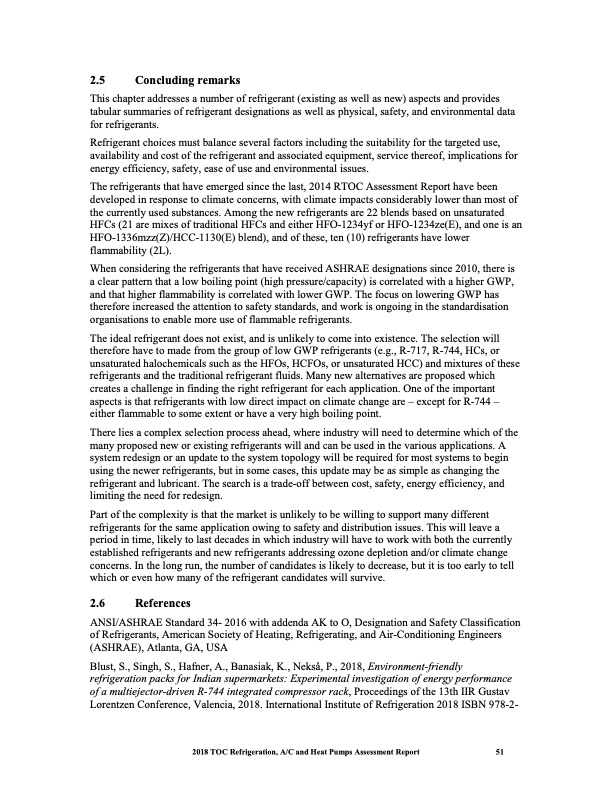
PDF Publication Title:
Text from PDF Page: 064
2.5 Concluding remarks This chapter addresses a number of refrigerant (existing as well as new) aspects and provides tabular summaries of refrigerant designations as well as physical, safety, and environmental data for refrigerants. Refrigerant choices must balance several factors including the suitability for the targeted use, availability and cost of the refrigerant and associated equipment, service thereof, implications for energy efficiency, safety, ease of use and environmental issues. The refrigerants that have emerged since the last, 2014 RTOC Assessment Report have been developed in response to climate concerns, with climate impacts considerably lower than most of the currently used substances. Among the new refrigerants are 22 blends based on unsaturated HFCs (21 are mixes of traditional HFCs and either HFO-1234yf or HFO-1234ze(E), and one is an HFO-1336mzz(Z)/HCC-1130(E) blend), and of these, ten (10) refrigerants have lower flammability (2L). When considering the refrigerants that have received ASHRAE designations since 2010, there is a clear pattern that a low boiling point (high pressure/capacity) is correlated with a higher GWP, and that higher flammability is correlated with lower GWP. The focus on lowering GWP has therefore increased the attention to safety standards, and work is ongoing in the standardisation organisations to enable more use of flammable refrigerants. The ideal refrigerant does not exist, and is unlikely to come into existence. The selection will therefore have to made from the group of low GWP refrigerants (e.g., R-717, R-744, HCs, or unsaturated halochemicals such as the HFOs, HCFOs, or unsaturated HCC) and mixtures of these refrigerants and the traditional refrigerant fluids. Many new alternatives are proposed which creates a challenge in finding the right refrigerant for each application. One of the important aspects is that refrigerants with low direct impact on climate change are – except for R-744 – either flammable to some extent or have a very high boiling point. There lies a complex selection process ahead, where industry will need to determine which of the many proposed new or existing refrigerants will and can be used in the various applications. A system redesign or an update to the system topology will be required for most systems to begin using the newer refrigerants, but in some cases, this update may be as simple as changing the refrigerant and lubricant. The search is a trade-off between cost, safety, energy efficiency, and limiting the need for redesign. Part of the complexity is that the market is unlikely to be willing to support many different refrigerants for the same application owing to safety and distribution issues. This will leave a period in time, likely to last decades in which industry will have to work with both the currently established refrigerants and new refrigerants addressing ozone depletion and/or climate change concerns. In the long run, the number of candidates is likely to decrease, but it is too early to tell which or even how many of the refrigerant candidates will survive. 2.6 References ANSI/ASHRAE Standard 34- 2016 with addenda AK to O, Designation and Safety Classification of Refrigerants, American Society of Heating, Refrigerating, and Air-Conditioning Engineers (ASHRAE), Atlanta, GA, USA Blust, S., Singh, S., Hafner, A., Banasiak, K., Nekså, P., 2018, Environment-friendly refrigeration packs for Indian supermarkets: Experimental investigation of energy performance of a multiejector-driven R-744 integrated compressor rack, Proceedings of the 13th IIR Gustav Lorentzen Conference, Valencia, 2018. International Institute of Refrigeration 2018 ISBN 978-2- 2018 TOC Refrigeration, A/C and Heat Pumps Assessment Report 51PDF Image | Heat Pumps Technical Options

PDF Search Title:
Heat Pumps Technical OptionsOriginal File Name Searched:
RTOC-assessment-report-2018_0.pdfDIY PDF Search: Google It | Yahoo | Bing
CO2 Organic Rankine Cycle Experimenter Platform The supercritical CO2 phase change system is both a heat pump and organic rankine cycle which can be used for those purposes and as a supercritical extractor for advanced subcritical and supercritical extraction technology. Uses include producing nanoparticles, precious metal CO2 extraction, lithium battery recycling, and other applications... More Info
Heat Pumps CO2 ORC Heat Pump System Platform More Info
| CONTACT TEL: 608-238-6001 Email: greg@infinityturbine.com | RSS | AMP |